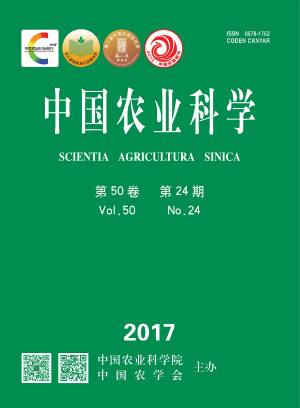-
Comprehensive Evaluation of Germplasm Resources of Upland Cotton in Xinjiang
- LIU XiangYu, ZHAO Long, BAHARGUL·Xamxi, PENG Hua, ABDUREYIM·Ibrayim
-
Scientia Agricultura Sinica. 2017, 50(24):
4679-4691.
doi:10.3864/j.issn.0578-1752.2017.24.002
-
 Abstract
(
472 )
Abstract
(
472 )
 HTML
(
3 )
HTML
(
3 )
 PDF (779KB)
(
391
)
PDF (779KB)
(
391
)
 Save
Save
-
References |
Related Articles |
Metrics
【Objective】Based on the morphological index, yield index and quality index, this study comprehensive evaluated the performance of the cotton germplasm resources in Xinjiang under the condition of seasonal water deficit in order to determinate main upland cotton cultivars and lay the foundation for the cotton cultivars improvement in Northwestern arid region.【Method】The comprehensive evaluation of quantitative traits about plant height, number of fruit branch, breeding time, effective boll number per plant, boll weight, lint percentage, seed index, seed cotton yield, lint yield, fiber length, fiber uniformity, fiber strength, fiber elongation, micronaire, fiber reflectance, yellow degree and SCI of 126 cotton varieties under the condition of seasonal water deficit were evaluated by correlation analysis, principal components analysis, hierarchical cluster analysis, stepwise discriminant analysis and multivariate analysis of variance etc.【Result】Firstly, the results of the correlation analysis showed that there is a certain correlation and overlap of information between 17 quantitative traits, because 56 of these coefficients is extremely significantly correlation at P<0.01 and 22 of these coefficients is significantly correlation at P<0.05. Secondly, the results of the principal components analysis showed that the first eight principal components represent 86.34% of the information which is the 17 quantitative traits of the 126 cotton varieties. The contribution rate is respectively 27.45%, 17.18%, 11.61%, 8.42%, 6.66%, 5.33%, 5.08%, and 4.63%.Thirdly, the results of the hierarchical cluster analysis showed that the 126 cotton cultivars were clustered into seven categories when the class separation distance is 12.5. Among them, the first classⅠ has 22 varieties, the class Ⅱ has 17 varieties, the class Ⅲ has 19 varieties, the class Ⅳ has 28 varieties, the class has 19Ⅴ varieties, the class Ⅵ has 13 varieties, the class Ⅶ has 8 varieties. Fourthly the results of the stepwise discriminant analysis showed that the results of cluster analysis are accurate and reliable, because 114 cotton varieties were correctly discriminated, which identification rate was 90.48% and 12 cotton varieties were incorrectly discriminated, which false identification rate was 9.52%. Finally, the results of the multivariate analysis showed that the seven categories of cotton varieties were evaluated scientifically and the corresponding improvement schemes were proposed, which were the classⅠwhich is the cultivars of middle yield and middle quality, the classⅡwhich is the cultivars of low yield and high quality, the class Ⅲ which is the cultivars of high yield and high quality, the classⅣwhich is the cultivars of middle- and high- yield and middle quality, the class Ⅴ which is the cultivars of middle- and high- yield and upper middle quality, the class Ⅵ which is the cultivars of high yield and middle quality and the classⅦ which is the cultivars of low yield and low quality.【Conclusion】On the one hand, the work of the cotton breeding in production in Xinjiang has a lot to improvement; On the other hand, most of the cultivars fall short of the requirements of high count cotton, besides the class Ⅵ and the class Ⅴ. The main upland cotton cultivars which are Suitable to Spin middle Count Cotton can be selected in the classⅢ. The classⅡare suitable to spin the high-quality cotton of high tenacity, but their yield indicators need to be improved. In future, in order to achieve the optimality which include yield and quality, the work of the cotton breeding in Northwestern arid region should be done by selecting suitable breeding strategies, according to different category of varieties.









